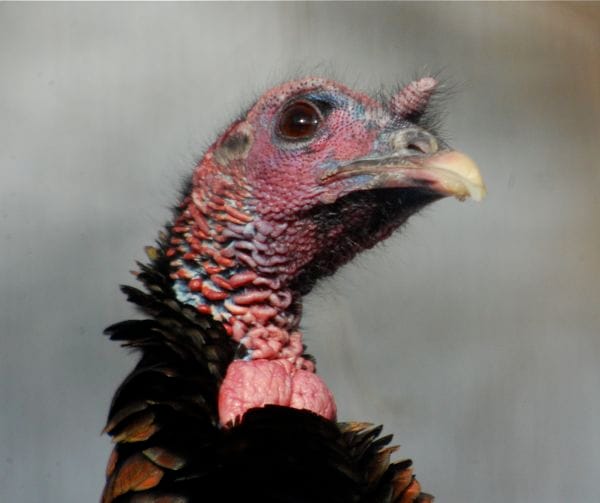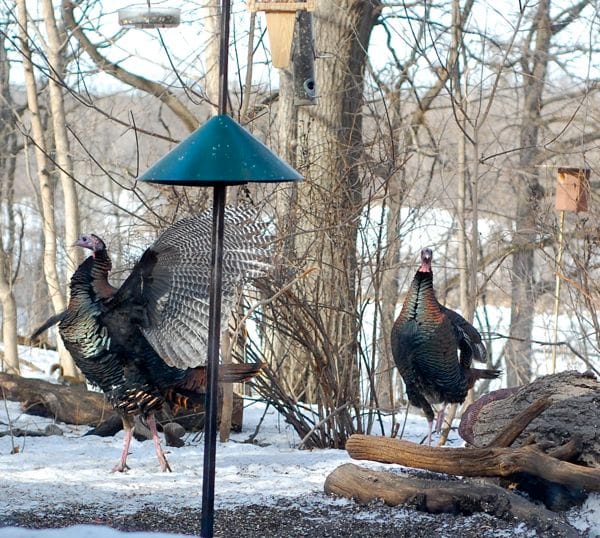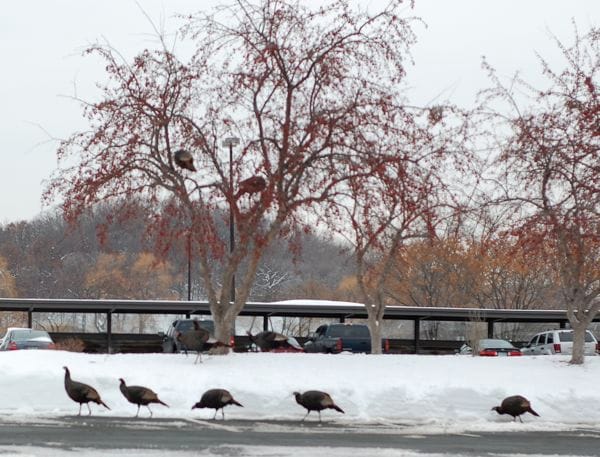What is up with all the frickin’ Wild Turkeys out there? They are running amok! This is the time of year when I tend to see turkeys dead on the side of the road. News stories of turkeys causing car accidents abound around the US right now. Where I live, a man driving on his way to work in a southwestern Twin Cities suburb slammed into a turkey (follow the link and check out the photos of his car and face–yikes). In Boston, a turkey was the cause of a 2 car accident during the morning commute. A woman in Ohio had a turkey crash through her windshield. In Connecticut, a woman’s vehicle was totaled after she hit a turkey, flipped a few times and slid 100 feet into the woods. In New Jersey, police shot a Wild Turkey that was causing a few fender benders. These are just quick turkey car accident links I’ve found on my usual birding news feeds, but I’m sure many more are out there.
Is this turkey contemplating your doom? I think the main reason turkey/vehicle collisions are more noticeable this time of year are breeding hormones. Males are competing for females and chases happen, either to drive out a rival or in pursuit of a hot piece of hen. To give you an idea of how strangely the turkey brain functions this time of year, studies conducted in the 1950s on turkeys found that males would attempt to copulate with an object so long as the female’s head could be seen in an upright position–it didn’t really need any sort of body at all, just the head on stick. If a hen body was around but no head, they weren’t so interested. Nice to note that male turkeys aren’t after a hen’s breasts.
With all that chasing and focus on hen heads, they may not notice the cars when they’re flying away. Also, a turkey fight and display will attract the attention of predators, I’m sure many a turkey lek gets ambushed by coyotes causing birds to flee in utter panic.
Wild Turkeys were a species of concern in the 20th Century and several reintroduction programs were tried, including the release of domestic turkeys (that didn’t work so well). But wild birds were caught and transferred to areas with habitat and now the birds appear to be adapting to suburban life and making bold attempts to adapt to urban areas too. As much of joy as it is to see such a large bird roaming the neighborhoods, it will make for more opportunities of turkey collisions with cars.
There’s also another issue–the spring turkey hunting season. There’s a story out of Wisconsin this week of a 5 year old boy that was shot because someone thought he was a turkey. Deer season is challenging enough to navigate and but everyone seems to wear orange an hunters in trees are easy to spot. Turkey hunters…not so much. That usually involves a ghillie suit. I actually have one and if you position yourself well, no one knows you are there. I’ve had hunters walk past me within 10 feet, completely clueless that I’m there. If you have several hunters going for turkey in one small area all hidden in ghillie suits, accidents can happen.
So, my birding friends, drive carefully on your way to view warblers and vireos and take heed if the area you are birding in is open for a spring turkey season.
















About two years ago, when I was living in Bismarck, ND, a turkey attacked my car and chased it down the road. I believe this happened around June. The best I could figure was that it saw it’s own reflection in the shiney surface of my car and thought it was a rival male.
someone shot him,because he thought he was a turkey? okkkkkkkkkkkkkk………….
You are so right Sharon. I had to swerve taking my wife to work a few morning ago also to keep from hitting 2 Turkey that were in the process of landing close to the road. And that was just a day break. They were off to an early breakfast I guess. Ya gotta be careful out there on the highway. Way to many Turkeys think they have the right of way…
Got to love mating season! I had one fly into driver side of vehicle & caused $2700 damage.
Today just south of Chadron Nebraska we were driving our motorhome approximately 60 mph when a huge turkey on the left side of the road flew right out in front of us. Fortunately it missed slamming in to our windshield. It did hit the passenger-side large mirror which retracted and slammed into the passenger side window. The mirror and rubber gasket holding it in both disappeared and white paint from the mirror is etched into the window. We were very lucky….the turkey, not so much. Very scary!!!
I hit a wild turkey yesterday going 70 MPH on an Indiana Interstate. The bird was just standing there in the lane. He seemed to just appear out of no where. No time to react, either of us, and he took out my right headlight and damaged the hood. I’m thankful he wasn’t in flight and landed in the windshield…so much for my new car I just bought 2 months ago…guess you could say I broke it in.
July 1st 2012 I was struct in the head by a turkey in West Virgina while riding my motorcycle at 70 MPH. It knocked me out cold. fortunately I wear a lot of protective gear so not major injuries but the concusion kept me out of work for 6 week even though I wear a full face helmet.